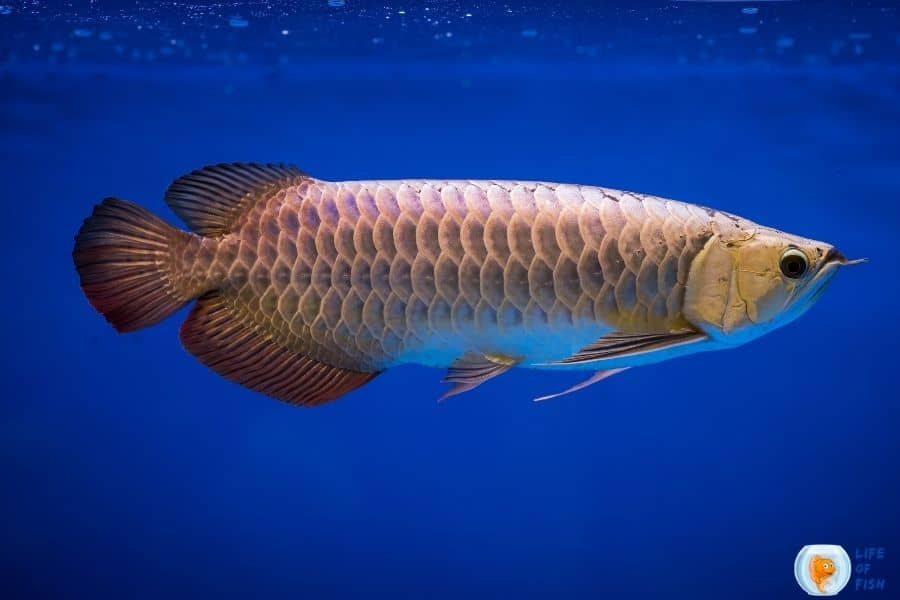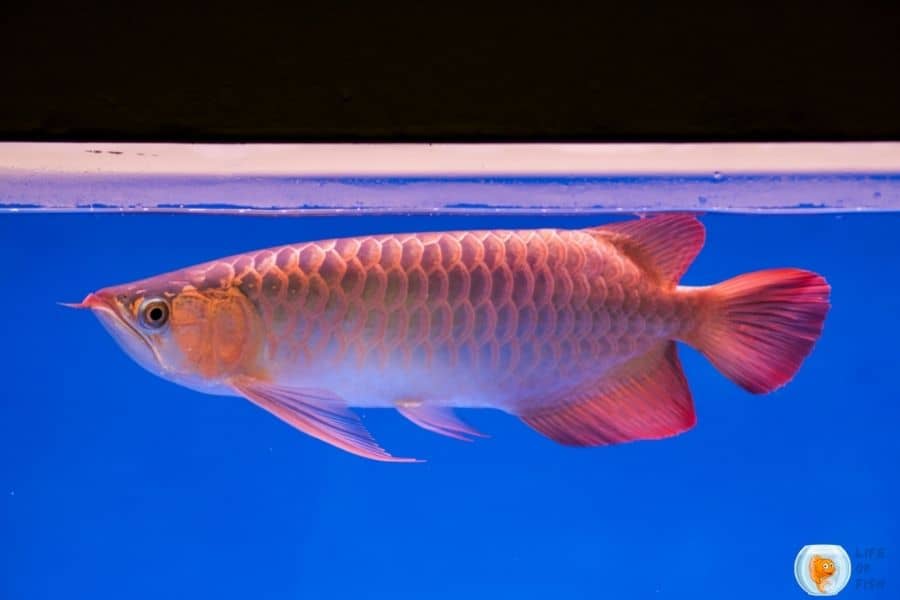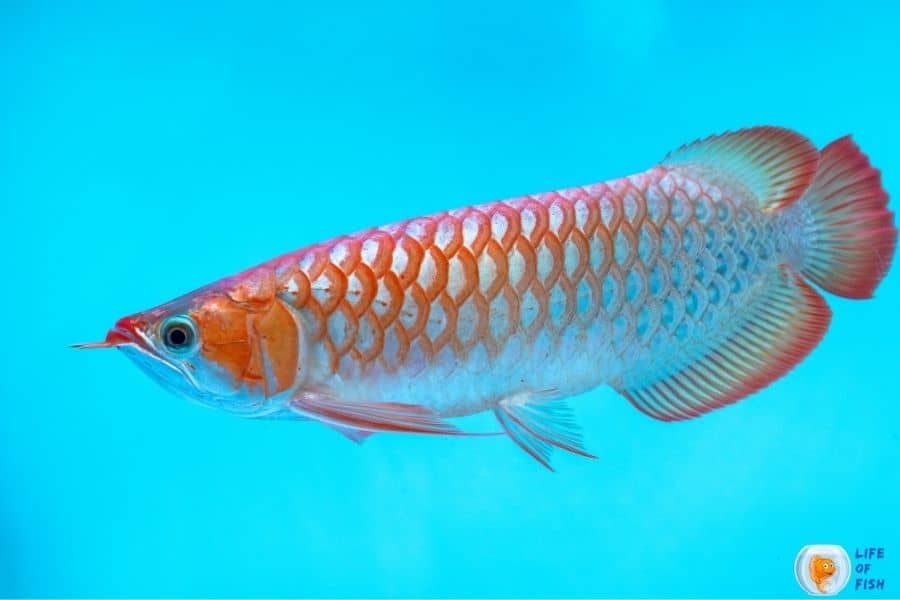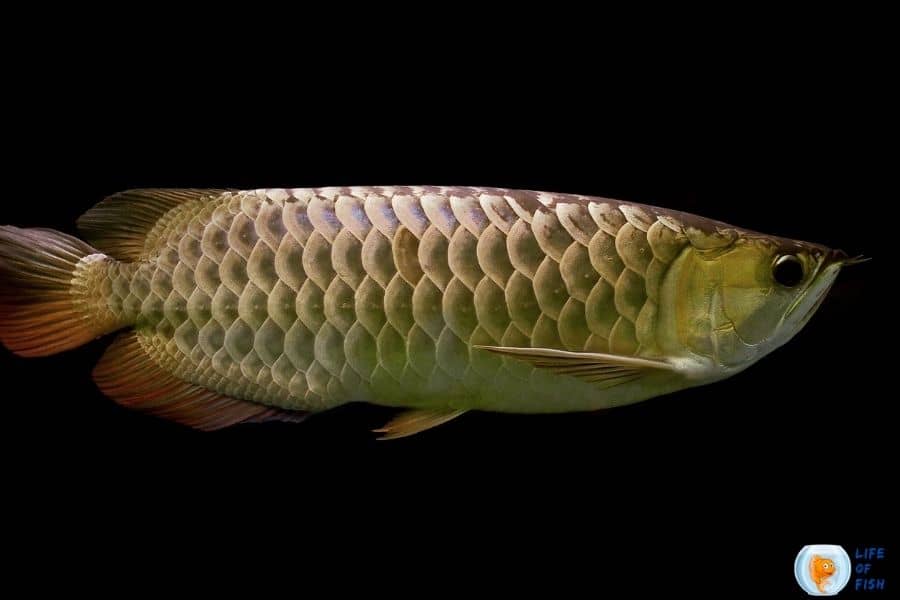Platinum Arowana is a rare fish that comes with beauty, uniqueness, and an expensive price tag. It is so captivating that it has become the dream fish of many exotic fish collectors worldwide.
Regardless of their enthralling look, these fish are illegal to keep in the United States.
This article will cover everything you need to know about platinum Arowanas, including how they live, their environment, and what distinguishes them from other aquarium fish.
We will also touch on some of the problems that platinum Arowanas face. Such as how difficult it can be for fish owners to provide an appropriate living environment for these exotic creatures.

What is platinum Arowana?
Jump To
- 1 What is platinum Arowana?
- 2 Why is platinum Arowana so expensive?
- 3 Is Asian Arowana rare?
- 4 Why is Arowana illegal in the United States?
- 5 Where is platinum Arowana found?
- 6 How big do platinum Arowana get?
- 7 Is platinum Arowana aggressive?
- 8 How platinum Arowanas behave?
- 9 Platinum Arowana Lifespan
- 10 Are platinum Arowana good pets?
- 11 Platinum Arowana care
- 12 Platinum Arowana breeding
- 13 Platinum Arowana Feeding
- 14 Can Arowana live with other fish?
- 15 Platinum Arowana Tank Mates
- 16 Related question
Scleropages formosus, commonly known as platinum Arowana, is a freshwater fish native to Southeast Asia. Due to their habitats, we use common names such as “Asian Arowana” or “Dragon Fish.”
In the aquarium trade, you can find about ten types of Arowanas categorized by their origin.
Among these, some Arowanas are considered as endangered species and listed as CITES level I.
They are also protected under the endangered species act in 1973. This act was signed by 180 countries and all those countries are bound to protect Arowana fish.
Sometimes, we can find this fish in Australia, Africa, and South America.
This particular species of Arowanas is a huge, metallic-colored fish with a long body with three sets of paired fins (pectoral, ventral, and anal fin along its abdomen area).
Its tail also has a captivating dorsal fin and a caudal fin. Those fins can reach up to three feet in length and weigh around five pounds when fully grown.
What makes platinum Arowana so unique is the distinctive features that set it apart from other types of freshwater fish: a metallic-colored body with platinum-colored dragon-like scales and a long elongated body.
Related: How Long Do Giant Betta Fish Live
Why is platinum Arowana so expensive?
They are so expensive in the aquarium trade because of their enthralling look and the difficulty in breeding them in captivity.
Some species of this fish are even listed as endangered species which makes them more demanding among aquarists.
Many believe this fish brings good luck to the owner, and they are one of the ancient ray-finned fish species that goes back to the Jurassic period.
Is Asian Arowana rare?
They are actually rare fish that is not common in the aquarium trade.
Due to their rare occurrence, they consider as one of the most expensive fish for sale, and they are worth as high as $300,000 per individual fish.
It will take a lot of effort and time to breed platinum Arowanas, so these fishes are usually found only in very few numbers in the aquarium trade.

Why is Arowana illegal in the United States?
As mentioned earlier, they are an endangered species.
So, you can legally trade them only if they come from sustainable sources, which primarily means fish bred through aquaculture facilities.
Unfortunately, it is very difficult to breed them in captivity because of their complex reproductive process.
Since platinum Arowanas are rare, they often come from unsustainable sources, such as illegally markets.
And you might be breaking the law if you own this species of fish without proper certification or permit.
Where is platinum Arowana found?
They originate from Asia, and they inhabit rivers, lakes, swamps, and other water bodies. They may also live in flooded forests.
Although platinum Arowanas live in Southeast Asia, particularly Indonesia and Malaysia, you can also spot them in Australia as well as South America and Africa.
How big do platinum Arowana get?
They can grow up to four feet in length and weigh as much as 25 pounds when fully grown. But, in captivity, they usually grow up to three feet long.
Is platinum Arowana aggressive?
They are aggressive fish that is not suitable for home community aquariums.
Full-grown platinum Arowana are enormous and can be dangerous to other fish in the tank, especially if kept with smaller or slow-moving species.
How platinum Arowanas behave?
Platinum Arowana is a nocturnal fish which means they are active during the night time and most of their activities take place at dusk or dawn.
They are territorial but will usually get along with other mating Arowanas that are of similar size.
But you have to introduce them at a young age. However, they become aggressive when they reach adulthood.
Arowanas are fierce predators, so platinum Arowanas will go after any fish that enters the territory they have claimed and eat it.
So, as you see, you better leave them alone in a large enough tank. This fish can jump out of the tank very easily, hence they are also known as monkey fish

Platinum Arowana Lifespan
In the wild, platinum Arowanas can live up to 20 years or more.
In captivity, Platinum Arowanas can reach 15 – 18 yrs of age if we provide perfect conditions, and you take good care of these fish.
To increase the chances of platinum Arowanas living longer, make sure that to keep them in large aquariums or ponds located in well-lit areas to provide platinum Arowanas with the proper lighting and temperature need.
Are platinum Arowana good pets?
They are not suitable pets for beginners because of their large size and aggressive behavior, so you need to have extensive experience before attempting to keep one.
Platinum Arowana care
They require large tanks with plenty of room for swimming. Since they are a giant-sized breed with a bad temper, taking care of these fish requires lots of experience.
Therefore, we recommend these fish only to an experienced aquarist.
Platinum Arowana size
They can reach a length of up to four feet when fully grown. But, most of the time, they don’t grow more than three feet in captivity.
Platinum Arowana tank size
When keeping them, make sure to buy at least 300 gallons aquarium or bigger because platinum Arowanas grow very big in the wild and in captivity.
But it is not necessary. You can keep them in 200 gallons aquarium, but make sure platinum Arowana is the only fish in that tank.
Related: Jardini Arowana (Scleropages Jardini) | Ultimate Care Guide |
How many platinum Arowana can be kept together?
You can not keep more than one of these fish in a tank because they are very aggressive and territorial.
Tank setup
They are surface-dwelling fish, so you’ll need to set up the tank accordingly. In addition to a large tank, platinum Arowanas also need lots of surface areas where they can rest.
Substrate
Since these are surface-dwelling fish, they don’t have specific substrate requirements. They will do fine with any substrate of your choice.
Current
Their natural habitats have minimum water flow, so platinum Arowanas prefer a surrounding with minimum to no current around.
These fish think of water currents made by powerheads and filtration units as a challenge and may try to attack that equipment.
So, when installing that equipment, you should aim to have a minimum water current.
Filtration system
They also tend to stay at the top of tanks because that’s where they feel most comfortable and secure.
So having a robust filter is not always necessary, but it will be good if your tank has one since platinum Arowana produces a lot of waste, especially when they are young.
Lighting and decorations
It is not necessary to have any unique lights or decorations in a platinum Arowana tank.
Still, if you want, we recommend no more than two inches of fine sand substrate for your platinum Arowanas.
Although these fish can tolerate intense lighting, they prefer moderate-dim lighting in their surroundings.
Plants
If your tank is on the smaller side, we highly advise staying out of plants.
But, if you can provide a larger tank of more than 300 gallons, you can fill up with large, firmly rooted plants like Anubias sp., Java Fern, and Amazon swords.
Additionally, you can grow too small plants like Java moss and chain sword plants which fish can not reach to uproot.

Water quality condition
Since there are tropical freshwater fish, they need similar water conditions in their environment. Ideal water conditions are as below.
- pH: 6.0-7.0
- Temperature: 75-83°F
Special tips
Platinum Arowanas leap for their prey in the wild, so having a tight-fitting lid with no escape points is essential.
Platinum Arowanas are floor sight hunters. Thus when they don’t have anything to hunt on the floor, their eyes glide downwards, making their eyes “droopy.”
You can fix this with a trained veterinary surgical procedure, but it will be a temporary fix because the fish is used to find food from the bottom.
Platinum Arowana breeding
They are very difficult to fish to breed in the aquarium.
It requires complex conditions where an experienced hobbyist should constantly monitor water temperature, pH level, oxygenation, and salinity for successful breeding.
Many platinum Arowanas available in the market are wild-caught ones. Therefore, keeping these fish is prohibited in the United States.
Female fish are bigger in size compared to the male. However, identifying the sex is difficult because no other distinctive feature appears in both sexes.
This is the greatest challenge hobbyists face as they can not house two males or two females together without knowing the gender.
If housed together, both fish will become aggressive and attack each other.
The females will be ready for breeding at the age of five years old. They are mouthbrooding fish.
Once spawned, the male carries the fertilized eggs in his mouth until they hatch. It will take about 50 to 60 days for the eggs to hatch, and the male doesn’t eat all this time.
Platinum Arowana Feeding
They are carnivores, and in nature, they feed on other fish, insects, and small reptiles.
In the aquarium, platinum Arowanas can be fed with live foods, fresh or frozen meaty items like small fish, earthworms, crickets, etc.
In aquariums, they prefer live food such as shrimps, crabs, small fishes, bony fishes like catfish or tilapia, and insects.
Also, they need to eat once in two days, so if you plan not to feed them for one day, make sure they have enough food before that.
If possible, let your fish hunt for food from the floor. Put their food on the water surface and try to keep them there until the fish eat it.
If your Arowana is used to eating pelleted food, do not feed them with live food. Otherwise, your fish will refuse to go back for the pelleted diet.
While it can be “fun” and “natural” for your Arowana to hunt living fish, it is intimidating for the prey.
So, if possible, feed your fish with frozen or freeze-dried food if it refuses pelleted food.

Can Arowana live with other fish?
Unfortunately, platinum Arowanas can not live with other fish because they are not just aggressive to others, but also their mouth is big enough to swallow large-sized fish.
If you plan to keep platinum Arowana in the aquarium, it must be kept alone or with one or two of its own kind.
Even keeping them together will make your platinum Arowanas more aggressive towards each other.
Platinum Arowana Tank Mates
If you still want to keep them with fish, then make sure the prey is too large and bulky for your platinum Arowana’s mouth, such as redtail catfish or channel catfish and some cichlids like discus and angelfish.
Related question
Platinum Arowana price
When platinum Arowanas are available in the market, they can be traded at prices as high as $300,000 per individual fish.
Do platinum Arowanas have teeth?
Yes, platinum Arowanas have teeth, and their appearance is very much like common Arowana, except platinum Arowanas have reflective scales that shine and look glittery.
Can I keep Oscar with Arowana?
Since both fish are large fish species that grow very fast, you can keep these two fish together from their juvenile age.
However, when they mature, they may become aggressive to each other, especially when the tank is not big enough.
How do I know if my Arowana is stressed?
Look for signs such as rapid breathing, continuous movement, and elevated fins. Platinum Arowanas also display stress with an increase of fighting among themselves, and they may refuse to eat.
Read Next : How Do Starfish Reproduce? | 14 Useful Facts From Experts |
